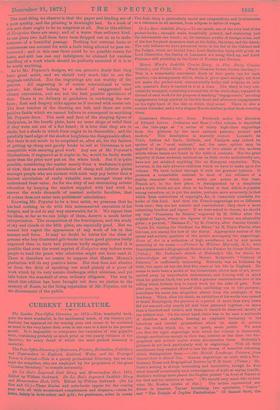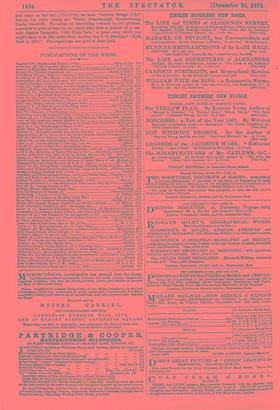CHRISTMAS Boors.—Art Gems. Produced under the direction of Edward Lievre.
(Sotheran and Baer.)—The volume is described 'on the title-page as "a series of thirty high-class engravings from the pictures by the most eminent painters, ancient and modern." This description is scarcely correct. Leonardo da Vinci, Andrea del Sarto, Holbein, and Vandyck may indeed be spoken of as "moat eminent," and the same epithet may be applied to Ingres, and possibly to one or two others of the modern artists whose names are found in the table of contents. But the great majority of these moderns, meritorious as their works undoubtedly are, have not yet attained anything like an European reputation. This, however, is the only adverse criticism which we have to make upon the volume. We have looked through it with the greatest interest. It presents a remarkable contrast to most of the volumes of similar character which come under our notice at this time. French art, in the first place, is distinguished by a simplicity and a truth which are not often to be found in that which is popular among ourselves, or, to put the matter, perhaps, more accurately, in that which from restrictions of copyright, leo., is commonly available for books of this kind. And then the French engravings are so different from ours ; they are not smooth and conventional ; they show a most refreshing freedom and vigour. If wo were asked to choose, we should say that "Francesca da Rimini," engraved by M. Didier after the original of Ingres, where the figures of the two lovers are admirably given ; a portrait, " Madame F.," by M. Courtry, after Carolus Durais ; "Louis XI. visiting the Cardinal La Balue," by M. Feyer-Perrin, after Gifirtime, are among the beat of the thirty. .Appropriate notices of the career and artistic qualities of the artists accompany the engravings. Gems of Art is a collection of high excellence, not by any moans unworthy of its name.—Pictures by William Mulready, R.A., with. Descriptions and a Biographical Sketch of the Painter by James Dafforno. (Virtue.) Mr. Dsfforne's sketch of Mulready's life, for which he acknowledges an obligation to Messrs. Redgrave's "Century of Painters," is sufficiently interesting. Mulready was an Irishman by birth, but spent all but the first five years of his life in England. He seems to have been a model of the industrious, clever man of art, never carried away by unprofitable enthusiasms, and bearing well in mind what his patrons liked, but yet with a genuine conscientious love of his calling which forbade him to hurry work for the sake of gain. Year after year, he contented himself with exhibiting one or two pictures ; sometimes his name was altogether absent from the catalogue of the. Academy. When, after his death, an exhibition of his works was opened at South Kensington, the pictures of a period of more than sixty years did not amount—for nearly all had been gathered together—to more than a hundred and twelve, and these, it should be observed, mostly of the cabinet size. On the other hand, there was to be seen a multitude of sketches and studies, bearing an emphatic testimony to the laborious and careful preparations which he made in private for the works which he, so to speak, made public. We must own that the eight engravings with which the volume is illustrated, though meritorious enough in their way, interest as less than the bio- graphical and artistic notice which accompanies them. Mulready's pictures do not look particularly well in engravings. With all their excellences they cannot afford to lose the charm of beautiful colouring which distinguishes them. —Our British Landscape Painters, from Samuel Scott to David Cox. Sixteen engravings on steel, with a Pre- liminary Essay and Biographical Notices by W. B. Scott. (Virtue.) Mr. Scott's writing is always interesting and instructive, though he does allow himself occasionally such extravagances of style as saying that Mr. Ruskin's writings have placed the English painter " in front of Nature as his God and his mistress at once," (We should very much like to hear what Mr. Ruskin thinks of that.) The artists represented are fifteen in number, Turner tarnishing two specimens, " Venice " and " The Temple of Jupiter Panhellenins.' Of Samuel Scott, the
first name on the list (1710-1772), we have "London Bridge, 1745." Among the other names are Wilson, Gahm:thorough, Lontherbourg, Danby, Stanfield. We notice an interesting contrast in two pictures, separated in point of time by not much more than a quarter of a cen- tury, Patrick Nasmyth's "Old Hyde Park," a rural scene which you might fancy to be fifty miles from London, and J. D. Harding's "Hyde Park in 1851." The engravings are good of their kind.







































 Previous page
Previous page